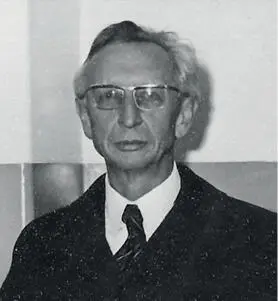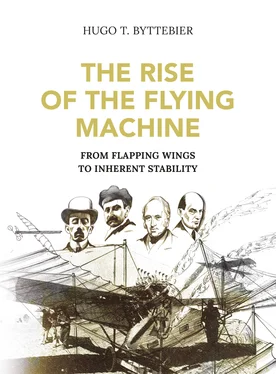[no image in epub file]

Byttebier, Hugo T.
The Rise of the Flying Machine : from flapping wings to inherent stability / Hugo T. Byttebier. - 1a ed. - Ciudad Autónoma de Buenos Aires : Autores de Argentina, 2021.
Libro digital, EPUB
Archivo Digital: online
ISBN 978-987-87-1388-5
1. Narrativa Argentina. I. Título.
CDD A863
© Conrado Miguel F. Byttebier, Federico Lorenzo M. Byttebier and María Elena Byttebier de Ojea Quintana
Copy editing: John Maher
Proofreading & general coordination: Julián Chappa
We are very grateful to André Delbaere’s family for the cession of the reproduction rights of all the exceptional illustrations of the main world aviation pioneers that appear in this book.
HUGO T. BYTTEBIER

(4th April 1924, Wulvergem, Belgium –
25th March 2004, Hurlingham, Buenos Aires, Argentina).
As an adolescent he developed a passion for the history of aviation. He worked tirelessly during more than 30 years to give us this great and complete historical work. It required the reading and research of more than 165 historical books, and countless magazines, newspapers, encyclopaedias and exhibition pamphlets, many of them original editions from the late nineteenth and early twentieth centuries that are still kept in his vast and valuable library.
In 1972, his book The Curtiss D-12 Aero Engine, a study of the first successful engine built in aluminium block between the two world wars and the precursor of many engine designs, was published in the Smithsonian Air and Space Museum’s “Annals of Flight” series.
He contributed with other writers to various aviation magazines, and donated generously to the Circle of Aeronautical Writers in Argentina.
He died shortly after finishing this work, so his family and many of his friends wanted to publish it for its historical value, as a detailed explanation of how the pioneers of powered and manned flight developed the inherently stable aircraft we know today.
The publication of this book is a posthumous tribute from all who knew him to Hugo and his historical rigour.
Part 1
Preface
To add another history of human flight to the many already published seems like an unnecessary undertaking. Yet, as in many other areas of knowledge, a subject can be approached from various angles and the present study is one more proof of this.
For a long time the author was puzzled by what seemed to be an incongruity. A great number of aviation historians arranged their chronicles around what was considered to be the crowning event: the first recorded, powered and manned flight in history. All previous and later historical events were made to appear of lesser importance or as in some way deriving from that one spectacular achievement.
Yet, when one studies the data available objectively, such a position cannot be held because of two undeniable facts: first, the type of aeroplane that is in general use today has its roots in the vision and work of the most enlightened pioneers of the nineteenth century. And second that the flying machine that made that much-heralded first flight was built according to a concept that stayed outside the mainstream of aviation development, a concept that eventually proved impractical and which had to be abandoned.
One may thus feel that there is some justification for believing that aviation history can be approached from a different angle, one which gives more importance to the continuous evolution that began in the early years of the nineteenth century and progressively led to the modern aeroplanes that exist today.
Another aspect that should not be ignored is the impact that this first flight had on the burgeoning aviation movement of the early twentieth century when the ultimate objective seemed so near, as indeed it was, and the misguided attempt to turn what the inventors believed was the technical predominance of their design into a monopoly and the controversy that followed. It all adds to the fascination that accompanies many a tale of human struggles with their corollaries of triumph and despair.
Introduction
From time immemorial, man has burned with the desire to emulate the flying creatures with which nature has endowed the world in such great profusion. Yet, as long as his approach was idealistic and not scientific, no progress was made and any attempt to copy the bird and its complicated flapping wings was doomed to failure.
For many centuries, the only flying beings were mythical and mythological gods or heroes whose existence remained outside the plane of reality. That all efforts to imitate the flight of the bird were to remain futile is obvious when we take the trouble to observe an aeroplane passing overhead.
It is not necessary to use one’s eyes to become aware of the presence of the machine because the first characteristic that strikes us is the noise it makes. That noise derives from the powerplant without which no horizontal flight is possible.
When we look at the aeroplane flying above us, we see a vehicle consisting of a streamlined fuselage carrying a fairly big monoplane wing that remains immobile. At the tail end, we note a small horizontal plane attached to it and on top stands a vertical fin, both as fixed as the wing. Only scrutiny at close quarters will reveal that the wing has small moving surfaces at the tips and others fitted at the rear end of the horizontal tail and of the vertical fin.
We all know what these moving parts are for. They are needed to direct and control the aeroplane in flight, along the three axes. The purpose of the wings is clearer still. They are there to lift the aeroplane and carry it through the air. But the purpose of the fixed tail and of the fin is not so commonly grasped; they are there for the sole purpose of keeping the aeroplane on an even keel, and without these fixed appendices safe flying would be as impossible as without the wing.
Leonardo da Vinci, the first Appreciation
The first attempt to study the laws that govern flight and to design a machine that would enable man to fly was made by Leonardo da Vinci around 1495/1500. Leonardo was the first genius of the Renaissance to recognize the endless possibilities of man-made mechanisms and he proceeded to fill notebooks with designs which are still in use today such as the parachute, the ball bearing, scissors, the odometer, portable bridges, and many more that have hardly been improved. Leonardo was one of the first to discover that by means of “an apparatus consisting of a number of rigid or elastic parts linked together in such a way as to have their motion completely determined, almost anything could be done”.
The idea of attempting flight with a man-made apparatus was too appealing to be left alone and Leonardo filled several more pages of his notebooks with designs, drawings and calculations so as to produce a machine that would enable man to fly. In the process, he invented an aerial screw, a parachute and a helicopter.
But in order to make horizontal flight possible, Leonardo had only the bird to guide his studies. He investigated the flapping movement of its wings and progressed from a machine moved by the arms to one moved by hands and feet but he finally became aware that man would never be capable of lifting himself into the air by means of even the most ingenious machine moved by his muscles, and across one of the last pages of his notes he wrote “ Non è vero ” and let the matter rest there.
Читать дальше














